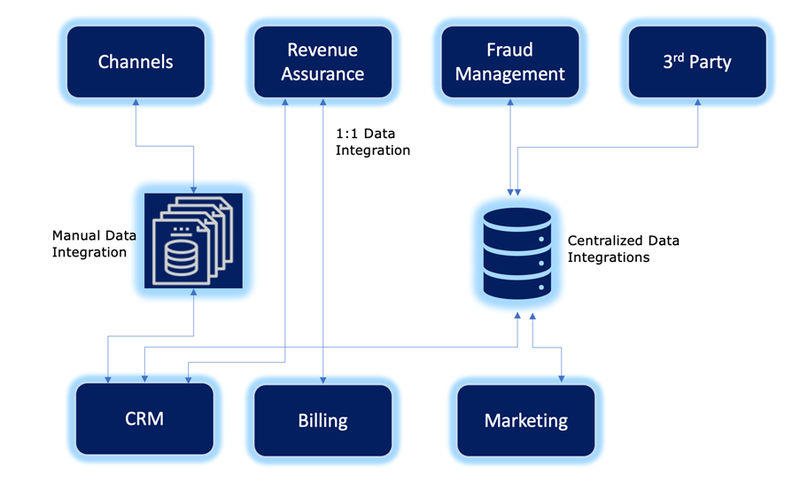Member Insights
Amazon Web Services highlight how combining TM Forum's Information Framework with modern cloud-native services enables telcos to streamline data integration, enhance governance and accelerate innovation through standardized architecture.

Harnessing TM Forum's Information Framework with modern cloud architecture
The telecommunications industry's data integration challenges require a fresh approach that combines industry standards with modern technology. The TM Forum's Information Framework (SID) offers a proven foundation, which when implemented with cloud-native services, creates a powerful solution for today's telcos.
Telecommunications providers face significant hurdles in managing data integration across their Business Support Systems. Manual processes requiring human intervention through spreadsheets and approvals slow down time-to-market, while years of tactical solutions have created a maze of point-to-point integrations. Though many telcos have implemented centralized data stores, these often demand substantial resources for infrastructure management rather than focusing on actual data integration. The situation is further complicated by data duplication across systems and the challenge of maintaining comprehensive governance and security. This complex landscape creates a costly, inflexible architecture that ultimately impedes business agility and innovation.

Figure 1. Illustration of current data integration patterns
The Information Framework transcends individual platforms by providing a standardized information model and common vocabulary. This standardization becomes particularly valuable when examining critical processes like customer bill collections within the customer domain. A telco implementing this framework can structure all billing-related data – from account details and payment arrangements to collection status and dunning processes – in a consistent, reusable format.

Figure 2. Customer domain – customer bill collection ABE
Traditional data integration approaches have created a complex web of inconsistent models and custom transformations. However, modern cloud services can help realize the Information Framework's potential. For instance, a data lake built on cloud based scalable, durable and highly available storage solution can serve as the foundation for implementing the framework's standardized business entities. This approach provides virtually unlimited storage while maintaining the structure defined by the Information Framework.
Consider a revenue assurance scenario where teams need to analyse order-to-cash processes. Data integration services can implement the framework's data models, automatically discovering and cataloguing data according to the Information Framework's specifications. The service's serverless ETL capabilities transform source data to align with standard ABEs – mapping CRM records to the Customer ABE, billing data to the Customer Bill ABE, and collection information to the Payment ABE.
The Information Framework's structured approach to data organization naturally complements modern governance tools. Data governance solution can enforce the framework's access patterns while maintaining security at various levels – from broad domains to specific attributes within an ABE. This creates a unified governance model that satisfies both business and regulatory requirements.
When implementing cross-domain processes, the combination of framework and technology proves particularly powerful. Source systems can write their data to centralized cloud storage, triggering data integration jobs that transform the information according to the framework's specifications. These jobs, orchestrated by cloud based serverless workflow services, ensure that human approvals and business rules align with the framework's definitions while maintaining complete audit trails.

This marriage of framework and cloud delivers tangible benefits. The standardized approach reduces development time as teams reuse established patterns. API Gateway can expose the unified data through consistent interfaces, while serverless interactive query services enables flexible querying across the standardized data sets. This comprehensive approach helps telcos move faster while maintaining data quality and governance.
As telecommunications companies continue their digital transformation, the combination of the Information Framework and cloud services becomes increasingly valuable. The framework's ability to standardize data models and relationships, implemented through scalable cloud services, creates a foundation for future innovation. This approach supports emerging needs like real-time analytics and AI/ML initiatives while maintaining the structure and governance that telcos require.
The telecommunications industry stands at a crucial juncture where data integration capabilities can either enable or hinder innovation. By implementing the TM Forum Information Framework through modern cloud services, telcos can create a data architecture that's both standardized and flexible. This combination transforms data integration from a technical challenge into a business enabler, supporting faster innovation and improved customer experiences.
Success in modern telecommunications requires not just managing data, but truly understanding and leveraging it. The TM Forum Information Framework, implemented through cloud-native services, provides the structure and scalability needed to achieve this goal. As the industry continues to evolve, those who embrace this approach will be best positioned to thrive in an increasingly digital future.